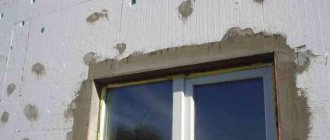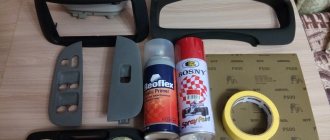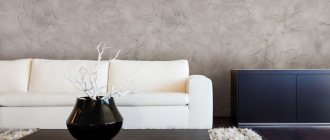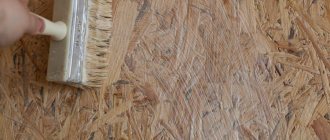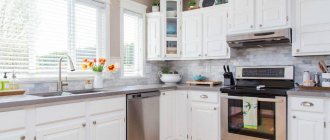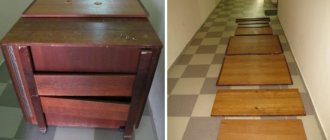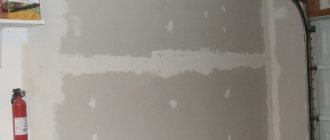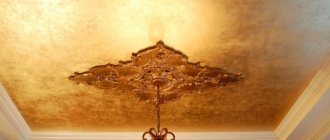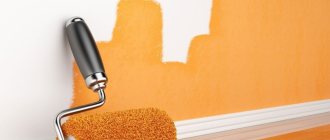Types and colors of paints for slopes, how to paint it yourself
An important part of the structural support of windows are window slopes (openings).
They are internal, external, as well as side and top. Window slopes are like a picture frame. The appearance of a room or building depends on their condition. Internal slopes can be made of plasterboard, chipboard, or have a surface plastered with gypsum plaster, painted, or wallpapered. Inside the building they are sometimes made of wood, plastic, glass, and mirrors. External openings are most often a cement mixture over brickwork, the color of which matches the shade of the facade.
White acrylic paint is most often used to paint indoor slopes. This color was not chosen by chance. White color in the decoration of internal openings reflects sunlight and makes the room brighter.
Paint requirements:
- decorative finishing;
- resistance to ultraviolet radiation (paint materials should not turn yellow in the sun);
- moisture resistance, vapor permeability;
- resistance to mechanical damage;
- coating strength;
- durability;
- resistance to detergents;
- non-toxic composition;
- compliance with operational requirements (weather resistance).
For the exterior finishing of openings, more water-resistant compounds are used that do not allow moisture to pass through, do not crack, and withstand temperature fluctuations. For painting external slopes, choose weather-resistant paints and varnishes that can withstand adverse weather conditions.
Which paint to choose
The dye is selected taking into account where it will be used. The main requirements for the coloring agent are:
- Aesthetic appearance, because the main purpose of the chosen paint is to create a worthy frame for a plastic window.
- Strength and abrasion resistance (the film formed after drying should not be damaged when washing the surface).
- Compliance with operating conditions (for example, for a bathroom this will be increased moisture resistance, and for outdoor work - the ability to withstand atmospheric conditions and temperature changes).
- Environmental friendliness (this requirement is mandatory for residential premises).
For interior decoration
Based on these requirements, experienced craftsmen recommend using the following compositions for interior work:
- Acrylic water-based. Easy to use, after drying they form a durable, beautiful film. They dry quickly, are easy to apply, have water-repellent properties and are suitable for painting slopes on bathroom or kitchen windows. Due to the fact that the solvent for such enamels is water, the compositions are non-toxic and almost odorless.
- Acrylic latex. They have the same properties as water-based ones, but the presence of latex additives in the composition increases their strength and moisture resistance. In addition, the addition of latex gives the dyes a beautiful gloss. If desired, you can purchase a coloring solution from glossy, which beautifully reflects light, to matte, emphasizing the beauty of the window opening.
For exterior finishing
For the street it is recommended to select the following paints:
- Acrylic latex with high protective and decorative properties. But it is worth considering an important rule: latex without additional additives is not sufficiently resistant to temperature changes and quickly breaks down. If you purchase latex paint for slopes, then the packaging should indicate: “For external use.”
- Alkyd, based on organic solvents, are suitable for any substrate and can withstand temperature changes. The downside is that they are highly toxic; you can only work with them wearing gloves or a respirator.
- Epoxy. Durable, beautiful, but expensive, and it can be difficult for novice craftsmen to work with them. They are rarely used for finishing windows due to the fact that there are more affordable coloring compounds with excellent protective and decorative qualities.
Assortment of shades
The choice of colors is huge. Remember that the original format of the slopes is white; think about whether the new shade will spoil the overall appearance of the room.
When using white, choose a shade that differs by a couple of tones from the factory one. Otherwise, there is no point in changing the look, and brighter or darker variations will not fit as desired.
If the room or house is decorated with wood, you need to choose a shade close to light wood.
The paint for the facade is taken so that it harmonizes with the overall cladding of the building. For interior decoration, choose glossy, which will visually expand the space, or calm matte. It looks more noble and neat.
The best latex paints for ceilings
Latex coatings are more expensive than others. But they adhere best to complex surfaces, masking minor irregularities.
The latex-based composition dries quickly and allows you to apply the next layer within a couple of hours. The finished coating is not afraid of water and remains elastic.
Beckers Elegant Takfarg – for masking minor defects
Matte white paint is easy to apply to most surfaces: plaster, brick, old paint, concrete, putty, fiberboard and drywall. Due to its thick consistency, it perfectly hides minor flaws and surface irregularities.
Beckers Elegant is suitable for rooms with windows on the sunny side because it is not susceptible to UV radiation and does not gray or yellow over time. And its good hiding power allows you to hide any other color of the base in just 2 layers. This paint is sold in 2.5 or 10 liter buckets.
Pros:
- does not fade in the sun;
- does not smell;
- hides small unevenness on the ceiling;
- can be washed;
- Available at most hardware stores.
Minuses:
- price about 800 rubles per 1 liter;
- not suitable for rooms with constant high humidity.
Takfarg is a wear-resistant compound and can withstand dry cleaning or washing with plain water. The main thing is not to use chemical cleaners so as not to spoil the coating.
Choice of colors
Manufacturers of paints and varnishes offer a wide color palette.
You can paint it in any color, but it is worth considering that plastic double-glazed windows have a traditional white color, and too bright a color window design can introduce dissonance into a carefully thought-out interior.
Designers recommend using the following color schemes for interior decoration:
- A shade of white, which will differ by 1-2 tones from the glass unit.
- Painted to match light wood species. This option will be an excellent solution for rooms with wooden panels.
For exterior painting, it is recommended to select the color so that it harmonizes with the façade finish.
Required Tools
Finally, the composition and color of the dye have been determined, now you need to select the necessary tools, and you can begin finishing the window. To make a quality finish, you will need:
- tools for leveling the surface (if necessary);
- masking tape;
- dye tray;
- gloves;
- painting tool.
The recommended painting tool is to use a brush or roller. When selecting a tool, experts recommend:
- Give preference to small and medium-sized rollers.
- Choose a “coat” for the roller from a sponge or natural fur with short pile. This is justified by the fact that rollers with long piles can splash paint compositions, and the splashes can get on glass or plastic.
- It is better to use brushes only for painting joints, and paint the remaining areas with a roller. This will allow you to achieve even coloring and save material.
How to properly prepare plastered slopes
Preparation is not difficult. You need to carefully check the surfaces around the windows for unevenness and cracks. If loose pieces are found, they must be pulled out. Eliminate identified defects using putty or cement mortar. Check the level of deviation in the horizontal and vertical planes. Cover the frames with masking tape, and cover the glass surfaces of the windows with paper or polyethylene.
The plaster needs to be primed twice. The second layer is applied after the first has dried. There is no need to paint until the primer is completely dry.
Painting
Volume calculation
The last thing I would like to consider in this article is the consumption per 1 m2 of paint when painting different surfaces.
Large manufacturers of paints and varnishes write directly on the can the area that can be covered with a given volume. But when planning a repair, you need to plan the amount of this substance in advance, and not stand in the store, reading the small text. To cover 1 square meter:
- plaster coating requires 0.08 liters of paint;
- processed wood – 0.07 liters per 1 sq.m.;
- primed plaster – 0.06 l.;
- wallpaper – 0.1 l. per 1 sq.m;
- untreated wood - more than 0.12 liters per square meter.
When calculating the amount of paint, keep in mind that most often paint is measured not in liters, but in kilograms, and one liter of water-based paint for interior work weighs from 1 to 1.4 kg, depending on its type. For more detailed information, please refer to the instructions for each individual sample.
Let's start painting
Regardless of the type of surface you plan to paint, use masking tape to seal the frame first. To do this, cut a strip equal to the length of the frame and carefully glue it. It is important to do this as evenly as possible to prevent staining of the frame, since after this it is almost impossible to wash it. Also, before work, prepare a container for paint - check whether the roller fits it and whether it will be convenient for you to work. After that, you can pour dye into it.
Painting drywall trim
After preparing the paint and putting on rubber gloves, you can begin painting. To do this, follow the step-by-step instructions:
- To do this, you first need to paint hard-to-reach places and joints, corners with a brush. It is recommended to use a brush that is not too wide for this; you need to base it on the standard width of your slopes.
- After painting the corners, use a roller to paint the main part of the wall. You should not go over one place several times with a roller, since due to the glossy surface, this can only spoil the aesthetics of the paint - it will form smudges and stains.
- Let the first layer dry. This will take from ten to twenty minutes, depending on the thickness of the layer you apply. After this, you can apply a second layer according to the same scheme - first hard-to-reach places with a brush, and then the main part with a roller. It is recommended to do this in one or two touches of the roller to one place so that the dye spreads evenly.
SovetRemont.com
Dear visitor to my blog! I think you yourself know how important the appearance of window openings is, why painting the slopes on the windows Therefore, I will not engage in demagoguery on the importance of this work and will immediately get to the point.
Preparing to paint slopes
To begin with, the slopes should have a white, clean, dust-free appearance.
You need to achieve this using finishing putty and sanding it with abrasive sandpaper. Perforated aluminum corners should be installed on the outer corners of the slopes; read how to do this here. After cleaning the putty, the slopes should be treated with a deep penetration primer. Attention: if during the process the primer gets on the plastic window frame or glass, then immediately remove it with a damp rag. The window sill should also be protected from contact with primer (for example, polyethylene secured with masking tape).
As soon as the primer has completely dried, we proceed to the next stage - we cover the window frame with masking tape. It is important to do this work carefully and correctly. Use wide masking tape. It should be glued along the entire perimeter, including the junction of the slope and the window sill. The strip of tape should run smoothly without bends, and be pressed as tightly as possible against the supporting frame of the window. Glue the tape along the entire length of the junction of the slopes to the frame with your hands, and then press it as hard as possible with a plastic spatula, this is necessary so that during the main work the paint does not flow under it, this is especially important in the corners of the window opening.
Painting slopes
As for the quality of the paint, it's up to you to choose. Everyone has different financial capabilities, but I still recommend not to buy cheap paint. When choosing, rely on the following three criteria:
- Over time, as it becomes dirty, the paint should be easily washed off with a foam sponge.
- Use acrylic, its service life is longer than that of a regular water-based one. When purchasing paint, pay attention to the manufacturer's instructions on the can. Some types of paints have a purely individual composition.
- If you order online, it will be much cheaper, and if you buy it using cashback, it will be 2 times cheaper! The same goes for buying household appliances or new furniture!
Open the can of paint and mix it thoroughly. Pour a small amount of paint into the tray. Painting should begin from the top slope, moving to the sides. In hard-to-reach junction areas we use a flute brush.
List of tools needed for painting:
- Paint roller
- Flute brush
- Paint tray
- Pliers or screwdriver (for opening paint cans)
Try to roll out the paint evenly with a roller without putting too much pressure on the tool, otherwise greasy streaks and streaks will appear. Before applying paint to the slope, first roll it out with a roller in a paint bath. Attention: the work is done in one go; under no circumstances should you take a break, leaving one side of the window slopes partially painted. If you do this, the paint will dry out and, continuing to work, you will put an extra layer on top of the already painted one. Thus, in this place, at a certain angle and lighting, a non-uniform spot will stand out. If you don’t want to paint the slopes in two approaches, then apply the paint as thick as possible. But again, I remind you, make sure to apply the paint evenly with a roller.
Tips for painting slopes from personal experience
Once you've painted, peel off the masking tape immediately! Do this carefully without haste, being careful not to touch the fresh paint with your hands. Why do you need to remove the tape right away? I answer: the fact is that as soon as the paint dries, it forms a single film, including the paint that got on the masking tape. And when you remove the tape from the window frame, you will pull the dried paint behind it. This results in an uneven painting border; the appearance of such work, to put it mildly, is not very good! If, for some reason, you did not remove the tape from the window frame and the paint has dried, then do the following; Using a standard paint knife with replaceable blades, cut the paint along the entire paint border. After this, you can safely tear off the tape.
Do not under any circumstances try to dry paint with any electrical appliances (heater, hair dryer). The paint must dry naturally, otherwise it will become covered with small cracks, or even completely move away from the base in large “scales”.
If the slopes are not cleaned very well and have large scratches, then use a roller with large pile. Such a roller will easily hide all the flaws of both the putty and its stripping.
For those who would like to make slopes from plasterboard with their own hands, see a fairly simple way to do this.
conclusions
It’s easy to decorate the slopes yourself, without involving an assistant. A positive result depends on correctly selected CM and auxiliary materials. The dye will apply evenly and the coating will be beautiful if the surface is prepared according to the instructions step by step. The decorating layer is updated if the style of the interior changes and its color fades.
Stages of painting walls in the kitchen
How to choose paint for painting tiles
Criteria for choosing paint for plastic windows
Painting drywall without putting putty
Flugger Dekso paint 5 advantages
- acrylic paint, washable, water-based, suitable for walls and ceilings;
- forms a beautiful, matte surface - gloss level 5;
- excellent covering power;
- excellent cleaning properties - Flugger Dekso 5 can withstand local cleaning with a sponge and a soft brush, without losing the quality of its appearance;
- durable, dirt-repellent coating that leaves no marks and ensures the removal of the most difficult stains;
- highest class of resistance to wet abrasion;
- constant level of shine as a result of touching and washing;
- ideal ratio of water-repellent properties and vapor permeability;
- diverse application - for various surfaces;
- marked with Ecolabel environmental certificate;
- the best choice for children's rooms, kitchens, corridors and high traffic areas.
Preparing for coloring
The preparation must be taken carefully and responsibly, since after painting all the defects and imperfections of the base will be clearly visible. In order for the surface to be as smooth and even as possible, it must be carefully prepared before painting; the following steps are performed:
- the base is inspected using a lamp, any dent, defect or unevenness is leveled using putty. Most often, unevenness is found on plastered, putty surfaces and on chipboard. When the base is leveled, you need to inspect again;
- After leveling the base, cleaning is carried out. Any contaminants are removed, such as dirt, dust, grease stains, etc.;
- the slope must be primed; this can be done using a special primer and a roller. After the soil has dried, an inspection is carried out again, and if uneven areas of the applied primer are found, this procedure is repeated.
Drywall slopes
The best option for finishing a slope is plasterboard. This option, however, has both pros and cons, but now we have a different goal, namely, to figure out how to paint the slopes on plasterboard windows.
In this case, it would be optimal to opt for water-based paint, which not only applies well, but can also be wiped off during use.
So, however, before you figure out what paint to paint plasterboard window slopes, you need to do some preparatory work.
Slope preparation
If you have recently installed drywall with your own hands, then you cannot immediately start painting. Have you puttyed the slope? If yes, then skip the next few paragraphs, as the information will be offered to those who have not yet done this work.
So, you need to take putty and carefully putty the joints between the slopes and the perforated corner, as well as those holes that remain after fastening with self-tapping screws.
Important! Before you putty the holes for the screws, you need to embroider them. To do this, crosswise cross the hole, protruding 3 mm in different directions. Now you can putty.
After you have putty, give the mixture time to set. Then, take the abrasive mesh in your hands and carefully walk over the putty areas, removing any unevenness. You can use a carrier; it will make it easier to see irregularities.
Very often, after painting, cracks appear at the junction of the slope and the frame, to avoid them you need to do the following:
- Using a painting knife, in which it is better to replace the blade so that it is sharp, make a small chamfer along the entire perimeter of the joint, which goes to a depth of about 1-3 millimeters, at an angle of 45 degrees in the frame.
- Prime the slot area immediately, but apply masking tape along the frame and slope, first retreating 1 mm from the slope and frame.
- Next, insert the tube with acrylic into the construction gun and fill the chamfer. After filling, you need to “embroider” - run your finger along the seam to remove excess acrylic, as well as align the joint.
Important! You need to use acrylic, not silicone! Silicone is not painted, but acrylic is quite easy, moreover, it is initially white.
After you apply the acrylic, you can start painting only after 12 hours.
We answer further the question of how and with what to paint the slopes. You will need to prime the surface using a convenient brush.
But while the surface dries, you can use tape and cover the entire frame so as not to stain it with paint.
Painting
So, let’s figure out what paint to paint the slopes of plasterboard windows. It is better to use, as already mentioned, water-based paint, you can use acrylic, less often, oil or enamel.
Moreover, it is advisable to choose non-cheap analogues, since more expensive options will require fewer layers for coating, and their operating time will be a level higher.
So, the painting process will look like:
- Use a small brush to paint corners and other places that are difficult to reach with a large brush and roller;
- Next, use a velor roller or brush to apply paint to the main surface.
It is preferable, of course, to use a roller - there is less consumption (since excess paint is removed right there in the ditch with the material), and the layer goes on smoother and more accurately.
Important! In order for the paint to lay evenly, the pile on the roller must be very small; such rollers are usually called “velor”.
However, if you are used to and know how to work with a brush, then no one argues.
The painting process is simple - move carefully over the entire surface, but you don’t need to paint the same place often, for this you can apply the paint after drying with a second layer along the plasterboard slope. And if you paint it like this right away, then sloppy “scars” may be created.
So, here’s how and with what you can paint plasterboard slopes on windows, now let’s look at the plastered counterparts.
Paint application process
Regardless of the design and material of the slopes, painting technologies differ slightly. The main differences relate to the preparation of surfaces for painting.
When all the irregularities have been smoothed out with putty, the surfaces have been sanded and primed, and wearing rubber gloves, you can begin to work:
- First, the plastic section of the window frame adjacent to the wall is sealed. You can run a silicone spray over the corners, removing excess with your finger or a soft rubber scraper. This will prevent paint from cracking at the junction of dissimilar surfaces.
- Hard to reach areas are being painted. A hair brush will help you get around the loops. The corners are processed with the same tool.
- For the main parts of the slopes, a roller is used. The technique, when the instrument is passed over one place several times, leads to the formation of streaks and uneven coloring. One pass is enough. Then the freshly applied layer should dry. For acrylic paints this is 10 – 25 minutes.
- Then the second layer is applied. Again using a brush for hard to reach areas and a roller for the main area. Finally, carefully remove the masking tape.
The final drying of the paint takes no more than 4 hours. During this period, it is especially recommended not to create drafts in the room. Since sudden changes in humidity and temperature negatively affect the polymerization process. During the day, you should also not touch the painted areas or expose them to other mechanical stress.
There is nothing difficult about painting the slopes yourself. If the paint is of good quality, the tool is prepared, and additional materials are at hand, just follow the instructions consistently and success is guaranteed.
Types of latex paints
Types of latex paints are divided either according to their composition or scope of application. There are different types of paints: acrylic, acrylic butadiene styrene, acrylic silicone, acrylic polyvinyl acetate. They all contain different polymers. And the names of other types of latex paints depend on the scope of application, they are: textured - for creating relief patterns, dripless - they do not drip, perfectly hide visible cracks, they are used for painting walls and ceilings, vinyl latex paints are also used for painting ceilings and walls, dense ones - for painting ceilings. In general, latex paints are the best option for high-quality but cheap painting. But you should not paint with such paints yourself, because one wrong movement of the roller can affect the overall appearance of the wall or ceiling, and in general there is a special technology for painting surfaces with latex paints.
Stages of finishing slopes
When installing double-glazed windows, chips and cracks inevitably appear on the outside and inside, which need to be repaired. Before painting the slopes on the windows, you need to carry out preparatory work, which consists of:
Scheme of the structure and insulation of the slope.
- There are cracks and crevices in the putty.
- Removing old paint, if any.
- Leveling surfaces.
- Sealing all cracks that appeared during the installation of double-glazed windows with special solutions.
- Primers for leveled surfaces.
- Painting slopes with your own hands.
Since slopes can be external and internal, you need to choose the appropriate paint for their repair. For external slopes, façade paint is suitable, and it is best to choose a vapor-permeable one: this will not allow moisture to settle and prevent the formation of mold. You can paint the slopes on the windows on the inside of the apartment with water-based paint, acrylic or enamel. Based on the shade, it is best to choose white, as it does not attract attention, visually expands the room, reflects sunlight and makes the room brighter.
Painting of the slopes is done after the primer layer has completely dried, otherwise the applied paint will collect in lumps and the work will have to be done again.
Painting with water-based compositions gives a matte effect, the enamel on the surfaces will shine, and acrylic paint does not change its external characteristics under the influence of ultraviolet radiation and sunlight. Each owner decides which paint to choose depending on his financial capabilities, the general style of the room and how many years its renovation is expected to last.
Suitable varieties
For painting external or internal slopes, paint and varnish materials are selected that not only create a decorative coating, but also meet operational requirements.
For interior decoration
To paint internal slopes you can use the following paints and varnishes:
- acrylic water dispersion (dries quickly after application, the coating is breathable, resistant to ultraviolet radiation, moisture and detergents, but careful surface preparation is required before painting);
- oil (gives a moisture-resistant and shiny coating, washes well, but the paintwork itself has an odor, and over time the film on the surface cracks);
- acrylic water-based (non-toxic, odorless, dries quickly, forms a coating that is resistant to abrasion, but does not tolerate frequent wet cleaning);
- alkyd enamel (the moisture-resistant coating can withstand frequent washing and heating up to 90 degrees, but the paintwork itself has a fire hazardous composition and a pungent odor);
- acrylate (the coating is resistant to moisture and can withstand frequent washing, but paintwork materials are expensive);
- latex (after painting it dries quickly, forms a coating that is resistant to wet cleaning, repels dirt, has a glossy or matte sheen);
- silicone (waterproof, vapor-permeable, light-resistant, but has a high price).
For outdoor use
The following paints and varnishes are used for painting external slopes:
- solvent-based acrylic (dries quickly, forms a moisture-resistant and vapor-permeable coating that is resistant to adverse weather conditions, but cannot withstand very low temperatures);
- epoxy (moisture-resistant, weather-resistant, durable, but has a strong odor);
- alkyd (a coating that is resistant to moisture and temperature fluctuations, but paintwork materials have a strong odor and a toxic composition);
- silicate (strong, waterproof, weatherproof, durable, but difficult to dismantle).
Nuances when painting slopes
After puttying, the slopes are painted using a hand roller with a fur coat. Apply the first layer of paint along its length, and the second coating is applied across it so that the direction coincides with the spread of light. The corners for radiators are coated with a brush. The choice of material depends on several points. The desire to save money by purchasing cheap paints leads to a reduction in the service life of windows. Our consultants recommend the best options for each consumer individually, which helps to maximize their performance characteristics. When selecting paints, you must be guided by the following criteria:
- dirt should be easily washed off with a soft sponge;
- Acrylic paints are used for coating; they last longer than water-based mixtures;
- When purchasing, pay attention to the manufacturer, since some of them make paints with a specific composition that is not suitable for slopes.
After the work is completed, the pasted tape is immediately removed. Do this carefully, making sure not to touch the fresh layer. And if the protective tape is removed after the paint has dried, it will pull the adjacent layer, which will create unevenness. The appearance will deteriorate, and such work cannot be called high-quality. Our service is to ensure that the painting of slopes and the price for the work meet all the wishes of our clients.
The information presented on the site is posted as a reference and is not related to the public offer.
Data on services, materials and prices ( the cost of the work performed depends on the materials used, the complexity of the repair, its volume, related operations, etc.
), are given as reference information and are not the subject of a public offer agreement, which is determined by Art. No. 437 clause 2 of the Civil Code.
To get detailed information, contact our manager using the contact form or call the number.
To find out the exact cost of your repair, you need to invite our specialist to calculate a detailed estimate.
Each object is discussed with the customer individually. Calling a specialist is FREE and does not oblige you to anything!
Order a specialist visit at any time convenient for you from 9:00 to 21:00.
Coverage Requirements
It should create a beautiful appearance so that the door does not get lost and looks attractive.
The resulting film should be very strong. When washing the surface, scratches and cracks should not appear.
The paint must be suitable for the operating conditions. If this is a bathroom, it should have increased resistance to moisture.
Painting of the external sides should be carried out with a special composition that will not react to temperature fluctuations and atmospheric influences.
Any composition must necessarily comply with all modern environmental requirements.
Slope installation
Plastered surface
Plastering slopes is a finishing method that is now not as common as, say, plasterboard, but let's look at how to paint such slopes.
Preparatory work
As with every job, the plastered surface needs preparation.
To do this, use a painting knife to cut off the excess paint foam, remove significant protruding irregularities, and apply putty in several layers. After puttying, you will need to go through an additional fine abrasive to remove minor defects.
Important! Plastering of external slopes should be done only with cement mortar, and the use of putty can only be done in the same way, on a cement base.
Otherwise, painting external plastered slopes will be no different from similarly finished internal analogues.
Taking masking tape in hand, carefully close the frame, and you can attach either plastic film or wet newspaper to the windows themselves for protection.
And now, feel free to prime the surface of the slope with a primer. Having waited the time allotted for the mixture to dry, we proceed directly to figuring out how and with what to paint the plastered slopes on the windows.
Painting the slope
For interior work, the same paints are used as those mentioned above for drywall (water-based, acrylic, oil, etc.), but for external surfaces you need to use only façade versions of water-based or acrylic mixtures.
The principle of operation is the same: the corners are painted with a small brush, and the main surface is painted with a roller or a large brush.
Window slopes need to be painted over at least two layers, and care must be taken to ensure that the room has a constant temperature and there are no drafts. Do not use any heating devices to dry the first layer - this method will only cause the paint to peel off much faster later.
Paint the next layer only when the previous one has completely dried!
But for street work you will have to choose the weather to be dry and windless. However, if there are still small defects on the surface in the form of lumps, specks, blades of grass, and even brush or roller hair, then when the layer dries, you can easily remove them with fine abrasive paper. And then apply the next layer.
As soon as you finish the work, carefully remove the tape protecting the frame. If this is not done immediately, but after the finishing layer has dried, then the tape may remove pieces of paint from the slope, but why would you do that?
The finished type of finishing - however, the doorway
So, how and with what to paint plasterboard and plastered slopes on windows, you now know what we are extremely happy about!
Choosing paint for window slopes
Now, in fact, let’s move on to the question of how to paint the slopes. The right choice of paint will affect not only the quality of the result, but also its durability. The choice of paint is determined, first of all, by the nature of the room in which the window with its slopes is located. If high humidity regularly occurs in the room, as, for example, constantly happens in the kitchen, then it is better to paint the slopes with oil-based or semi-gloss topcoat paints. For other rooms where there is no problem of high humidity, it is better to use water-based paint.
Let us remind you that if you choose oil paint, then it should first be diluted with drying oil for greater durability.
Let us note right away that paint for slopes should not be cheap. Moreover, you will need very little of it, so there is no point in saving. It’s better to take a small jar of good paint from a well-known foreign brand and know that it is guaranteed to last you five to six years. In a hardware store you can get advice on which paint will be better, I recommend Tikuril, it won’t change the shade you have chosen one iota.
Also, the choice of paint will also depend on the level of humidity in the room. If the humidity level is high, and this is typical, for example, in the kitchen, verandas of country houses, etc., then oil paint is necessary for such cases. Don't forget to mix it with drying oil for greater paint durability. For ordinary premises, water-based paint for window slopes is suitable.
Painting wooden windows, how to paint windows correctly and efficiently: photos and videos
What does it mean to paint correctly? It all starts with the choice of paint; it must be of high quality. Next is the technology of the process itself. Well, don’t forget that painting needs to be repeated at least once every 2 years, maximum - every 3 years. Because wood is a very vulnerable building material, and most of all it is afraid of moisture. It swells and warps, it is far from plastic!
So, you need to look for paint that has an elastic base, which would maintain its integrity during deformation and would not let water into the wood, preventing its destruction. But there are many types of wood. Remember: oil is better suited for soft breeds and in moderate climates. Well, buy glossy enamel if you have very old windows. Universal - suitable for interior and exterior work. And yet, on the south side, where there is more sun (and sometimes too much), it is wise to use light shades and even white (reflective) colors, but on the shady side, darker colors will be warmer.
Painting is preceded by some minor operations. Check all the valves, they may be loose and the screws need to be tightened or replaced. If the spillway does not fit tightly, you need to pin it. In other words, block all possible channels for water to get inside during a rainstorm. Next we move on to removing the old paint. Often this stage of work is skipped, considering it unnecessary - I’ll apply a thicker new one. Well, your new paint will come off as fast as your old paint.
So if you have wooden windows and you don’t want to end up without any windows at all, you won’t be able to avoid the procedure of systematically painting them with high quality. Fortunately, it’s not that complicated: you can easily do it yourself, devoting part of your next vacation. And then the service life of this joinery product will significantly increase.
In this matter, there are rules that must be known and strictly followed; But there are recommendations, you can listen to them or ignore them. So each painter makes a decision at his own discretion. It is important that painting wooden windows does not become a “stumbling block” for you in the future and a subject of family discord, if the next year after painting the windows take on their previous appearance.
Advantages of plasterboards with special properties
Based on operating conditions, it is advisable to use more advanced materials for the construction of slopes. Cost of moisture-resistant plasterboard —
is fully compensated by the possibility of operating slopes at an ambient humidity of 75-80%.
- Installation of moisture-resistant material is no different from installation of plasterboard wall. Read how to install walls and partitions from sheets in this publication.
- The moisture resistance of the base allows you to use the unique capabilities of modern water-soluble disperse paints.
- Ceiling plasterboard differs from wall panels in its great flexibility, which determines its use for creating slopes on arched openings.
In fire hazardous areas, fire-resistant plasterboard is used, the price of which is determined by its unique resistance to prolonged high-temperature exposure. If free choice is possible, the use of gypsum panel materials that structurally combine moisture and heat resistance is justified.
By consistently following the recommendations of installation technology, you can bring the quality of the work performed closer to a professional level. Sealing joints and interfaces is greatly simplified by using a moisture-resistant putty composition reinforced with polymer connecting tape.
Preparing the base and applying water-based emulsion
Next, the slope is again cleaned of dust that formed when rubbing the putty. It is better to use a construction vacuum cleaner for this, but you can also use a broom brush. The final stage of preparation before painting the slopes with water-based paint will be the application of a primer. Its type depends on the type of base. A universal solution is a deep penetration acrylic mixture, which has different performance properties. Sometimes the composition requires dilution.
If the slopes are made of plasterboard, which are joined to the plaster layer, then the contact area must be sealed with silicone sealant. There is a high probability of dampness on slopes, so it is better to treat the surface with an antiseptic compound or primer with the addition of appropriate components.
Painting slopes with water-based paint involves using a brush, with which you need to paint all corners and hard-to-reach places. With a roller you can paint the entire rest of the surface. The number of layers will depend on the degree of coverage. Usually three is enough. Each subsequent treatment is carried out only after the previous layer has dried.
Additional recommendations
If you don’t have construction experience, then don’t despair; the desire to do everything efficiently and correctly will overcome any doubts. As a rule, professionals do everything quickly because they are confident in their actions. Beginners weigh all the pros and cons, thereby treating the task at hand more carefully.
List of tips for the average person:
- To avoid cleaning the floors, it is recommended to lay down old newspapers or covering film. If paint gets on the window glass, it is better to immediately wipe it off with a damp cloth.
- If paint smudges remain on the surface, then after complete drying it is recommended to scrape them off with a staple and reapply the paint.
- When painting slopes in the kitchen, it is better to use oil-based paint, and in other rooms - water-based paint.
- In order for painted slopes to be admired for a long time, what is important is not the choice of colors, nor what exactly the surface was painted with, but the quality of the preparatory operations.


